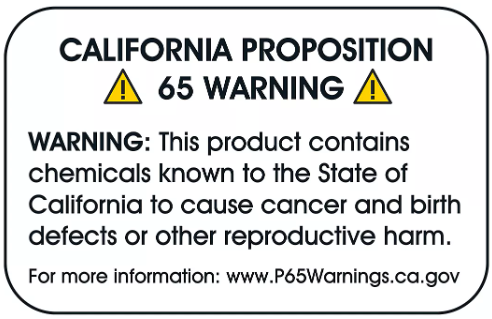- Applications of Safety Harnesses: Where Fall Protection Matters Most
- EN360:2023 vs EN360:2002: Key Differences and the Rising Demand for Horizontal Fall Protection
- Partnering with Brands for FIA Approved 6-Point Racing Harnesses
- Trusted Universal Seat Belt Supplier for Global OEMs and Vehicle Integrators
- Working at Height? Don't Risk It — How Trauma Straps Can Save Your Life
- Fall Arrester: Choosing the Right 2M Webbing Model for Safe Work at Height
- Understanding California Proposition 65: What It Means for Your Products
- 1 Tone Round Sling Achieves EN 795:2012 Type B Certification
- 5 Key Points to Consider When Choosing a Fall Arrester
- Fall Arrester Lifespan: What You Need to Know
Understanding California Proposition 65: What It Means for Your Products

California Proposition 65, officially known as the Safe Drinking Water and Toxic Enforcement Act of 1986, has been in effect since 1987. Commonly referred to as Prop 65, this regulation plays a crucial role in protecting consumers by requiring businesses to provide clear warnings about exposure to chemicals that may cause cancer, birth defects, or reproductive harm. For any company selling products in California—whether in-store or online—compliance with Proposition 65 is not optional, but mandatory.
Key Points of Proposition 65
-
Continually updated list of chemicals: More than 900 substances are currently listed, with new chemicals added or revised every year.
-
Broad responsibility: Manufacturers, distributors, and retailers must all ensure compliance.
-
Online sales included: E-commerce transactions with California consumers also fall under Prop 65 requirements.
-
Penalties for non-compliance: Businesses that fail to provide proper warnings may face substantial fines or civil lawsuits.
The Compliance Process
To remain compliant with Proposition 65, companies should follow four essential steps:
-
Identify chemicals present in the product.
-
Evaluate exposure levels to determine if they exceed the state’s safe harbor limits.
-
Provide warning labels if exposure levels are above the threshold.
-
Establish internal compliance management to ensure ongoing monitoring and documentation.
Prop 65 Warning Labels
The state provides model wording for businesses, such as:
“WARNING: This product contains chemicals known to the State of California to cause cancer and/or reproductive harm.”
Depending on the sales channel, the warning may appear:
-
Directly on product packaging
-
As a label or document accompanying building materials or retail goods
-
Clearly displayed on product pages for online sales
Redwood's Commitment
At Redwood, we take regulations like California Proposition 65 seriously. Beyond meeting compliance requirements, we view this as part of our broader responsibility to consumer health and product transparency. By closely monitoring regulatory updates and integrating compliance into product design and supply chain management, we ensure our customers can trust the safety and integrity of every product we deliver.


